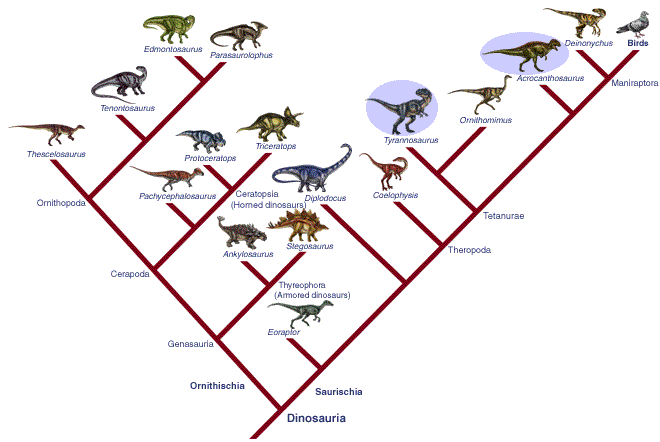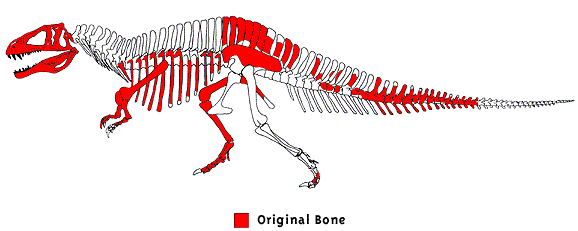Acro FAQ
- That’s a long name. How do you say it and what does it mean?
- Is Acrocanthosaurus as big as T. rex?
- Were Acrocanthosaurus and T. rex related?
- Why haven’t I heard of this dinosaur before?
- How old is it?
- What does it look like?
- What did it eat?
- Where did it live?
- Where did the Museum’s specimen come from?
1.That’s a long name. How do you say it and what does it mean?
Acro-can-tho-saur-us. It comes from Greek and means "high-spined lizard." Paleontologists J. Willis Stovall and Wann Langston, Jr. chose the name in 1950, because of the extremely long spines along the top of the dinosaur’s back, hip, and tail vertebrae. Its species name, atokensis, comes from Atoka County, Oklahoma, where the dinosaur was first found. People often call it "Acro" for short. The Museum of Natural Sciences gave its fossil a nickname, too: "Terror of the South.")
Return to Top2.Is Acrocanthosaurus as big as T. rex?
Not quite. But it was the largest North American predator of its time! Acro grew to nearly 40 feet long and 13 feet tall (measuring from the ground to the top of the pelvis). T. rex was about the same length, but taller and one to two tons heavier. Acro weighed 5,280 pounds (2.6 tons). Acro had a less muscular, narrower skull than T. rex, as well as longer, stronger forelimbs and shorter hind limbs. Its thinner teeth were used for tearing meat from bones, while T. rex’s thicker teeth could crush bones.
Return to Top3.Were Acrocanthosaurus and T. rex related?
No. Acro belonged to a different family of dinosaurs, unrelated to the ancestry of T. rex. Acro was more closely related to the Allosaurs — a group of large, three-fingered, two-legged meat-eaters. Tyrannosaurs had two-fingered forelimbs. Return to Top
4.Why haven’t I heard of this dinosaur before?
It’s very, very rare. Only four skeletal specimens have been found and most of the remainder are fragments or teeth. 54% of the original bones were recovered - click to enlargeThe Museum’s Acrocanthosaurus specimen is the best yet unearthed, with 54 percent of the bones represented, and the only one with a complete skull.Before this specimen was discovered, paleontologists couldn’t even determine the dinosaur’s general appearance. One other museum has a cast of Acro, but the N.C. Museum of Natural Sciences is the only place in the world to see the actual fossil.
Return to Top5.How old is it?
Acro lived during the Early Cretaceous Period, about 110 million years ago. That was 45 million years before T. rex appeared on the scene.
Return to Top6.What does it look like?
Acro has unusually prominent vertebral spines. Scientists are unsure what purpose they served but suspect they served to regulate body heat. Acro’s head is 4½ feet long, 3 feet high and 2 feet wide. Its jaw houses 68 thin, knife-like teeth. Its eyes face to the side, meaning Acro cocked its head on one side to examine its prey. Each 3-foot arm ends in three sharp, wickedly curved claws used to tear flesh from bones.
Return to Top7.What did it eat?
Acro was the only known giant carnivore of its time\. It preyed on dinosaurs larger than itself, such as the lumbering Pleurocoelus depicted in the Museum’s Terror of the South exhibit. Fossilized footprints show that it ran alongside its prey and then lunged, using its strong forelimbs to grip its prey. Scientists believe it attacked much like a modern lion attacks an antelope, but at a much slower pace. Return to Top
8.Where did it live?
Paleontologists have discovered fragmentary Acro remains in Oklahoma, Texas, and Maryland. Because of these finds, and because similar climatic conditions existed across the range during the early Cretaceous period, paleontologists believe Acrocanthosaurs lived throughout the entire Southeast, including North Carolina.
Return to Top9.Where did the Museum’s specimen come from?
It was found in southeastern Oklahoma and unearthed by Cephis Hall and Sid Love. They sold it to Grafham Enterprises of Ardmore, Okla. Anonymous donors purchased the $3 million Acro skeleton for the N.C. Museum of Natural Sciences in December 1997.
Return to Top



